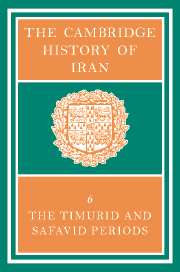Book contents
- Frontmatter
- 1 THE JALAYIRIDS, MUZAFFARIDS AND SARBADĀRS
- 2 TĪMŪR IN IRAN
- 3 THE SUCCESSORS OF TĪMŪR
- 4 THE TÜRKMEN DYNASTIES
- 5 THE SAFAVID PERIOD
- 6 THE SAFAVID ADMINISTRATIVE SYSTEM
- 7 EUROPEAN CONTACTS WITH PERSIA, 1350–1736
- 8 TRADE FROM THE MID-14TH CENTURY TO THE END OF THE SAFAVID PERIOD
- 9 SOCIAL AND INTERNAL ECONOMIC AFFAIRS
- 10 THE EXACT SCIENCES IN TIMURID IRAN
- 11 PERSIAN SCIENCE IN SAFAVID TIMES
- 12 RELIGION IN THE TIMURID AND SAFAVID PERIODS
- 13 SPIRITUAL MOVEMENTS, PHILOSOPHY AND THEOLOGY IN THE SAFAVID PERIOD
- 14 CARPETS AND TEXTILES
- 15 (a) TIMURID ARCHITECTURE
- (b) SAFAVID ARCHITECTURE
- 16 (a) THE PICTORIAL ARTS IN THE TIMURID PERIOD
- (b) THE ARTS IN THE SAFAVID PERIOD
- 17 (a) PERSIAN LITERATURE IN THE TIMURID AND TÜRKMEN PERIODS (782–907/1380–1501)
- (b) HĀFIZ AND HIS CONTEMPORARIES
- (c) PERSIAN LITERATURE IN THE SAFAVID PERIOD
- 18 PERSIAN POETRY IN THE TIMURID AND SAFAVID PERIODS
- Bibliographies
- Plate section
- Plate section
- Plate section
- Maps
- References
11 - PERSIAN SCIENCE IN SAFAVID TIMES
Published online by Cambridge University Press: 28 March 2008
- Frontmatter
- 1 THE JALAYIRIDS, MUZAFFARIDS AND SARBADĀRS
- 2 TĪMŪR IN IRAN
- 3 THE SUCCESSORS OF TĪMŪR
- 4 THE TÜRKMEN DYNASTIES
- 5 THE SAFAVID PERIOD
- 6 THE SAFAVID ADMINISTRATIVE SYSTEM
- 7 EUROPEAN CONTACTS WITH PERSIA, 1350–1736
- 8 TRADE FROM THE MID-14TH CENTURY TO THE END OF THE SAFAVID PERIOD
- 9 SOCIAL AND INTERNAL ECONOMIC AFFAIRS
- 10 THE EXACT SCIENCES IN TIMURID IRAN
- 11 PERSIAN SCIENCE IN SAFAVID TIMES
- 12 RELIGION IN THE TIMURID AND SAFAVID PERIODS
- 13 SPIRITUAL MOVEMENTS, PHILOSOPHY AND THEOLOGY IN THE SAFAVID PERIOD
- 14 CARPETS AND TEXTILES
- 15 (a) TIMURID ARCHITECTURE
- (b) SAFAVID ARCHITECTURE
- 16 (a) THE PICTORIAL ARTS IN THE TIMURID PERIOD
- (b) THE ARTS IN THE SAFAVID PERIOD
- 17 (a) PERSIAN LITERATURE IN THE TIMURID AND TÜRKMEN PERIODS (782–907/1380–1501)
- (b) HĀFIZ AND HIS CONTEMPORARIES
- (c) PERSIAN LITERATURE IN THE SAFAVID PERIOD
- 18 PERSIAN POETRY IN THE TIMURID AND SAFAVID PERIODS
- Bibliographies
- Plate section
- Plate section
- Plate section
- Maps
- References
Summary
One of the most distinguished European travellers drawn to Persia in Safavid times, Sir John Chardin, records a native saying in these terms: “Le doute est le commencement de la science; qui ne doute de rien n'examine rien, qui n'examine rien ne découvre rien, qui ne découvre rien est aveugle et demeure aveugle”. And he goes on to place both Persian and Chinese science next to that of Europe in achievement, qualifying his statement by adding that certain theorems which are regarded as new in the West are, in fact, to be found in the Persian and Arab books. But Chardin was impressed by the legacy of the past, for Islamic science, which had a strong Persian element, reached its zenith with Ibn Sīnā, al-Bīrūnī, 'Umar Khayyām, al-Khāzinī, and al-Tūsī, and, apart from a late burst of activity in Timurid times attributable to Ulugh Beg and his school, was then in decline. Medicine alone continued to make new advances.
There are, nevertheless, several influences which go to make this period in the history of science one of peculiar interest. Persia was a place of exchanges in ideas rather than a focus of original discovery. The protracted and bitter struggle between the Safavid monarchs and the Ottoman Turks, in the course of which the Persians became familiar with embassies from European courts, and Anthony Sherley is said to have suggested to Shah 'Abbās I an alliance with the Christian powers, not only generated an interest in technology, for the shah's armies were initially deficient in the heavier weapons of war; it also enabled Persia to know something of the scientific revolution which was gaining in momentum and influence in western Europe.
- Type
- Chapter
- Information
- The Cambridge History of Iran , pp. 581 - 609Publisher: Cambridge University PressPrint publication year: 1986
References
- 1
- Cited by



